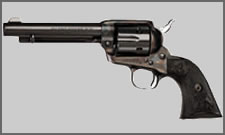- 01: Introduction
- 02: History
- 03: Propellants, Firearms, and Ammunition Development
- 04: Modern Firearms Manufacture
- 05: Small Arms Ammunition
- 06: Evidence Handling Procedures
- 07: Equipment and Instrumentation
- 08: Examination of Firearms
- 09: Cartridge and Shotshell Examination
- 10: Characterization and Evaluation of Fired Projectiles
- 11: Bullet Comparison and Identification
- 12: Gunshot Residue and Distance Determination
- 13: Toolmark Identification
- 14: Communicating Results
- Resources


Handguns
Home > Propellants, Firearms, and Ammunition Development > Evolution of Firearms > Repeating Firearms > Handguns

Early Colt handgun
A pattern still seen today in the modern revolver was the cylindrical chamber with the charge holes parallel to the long axis of the cylinder. Compact and reliable percussion ignition allowed manufacturers (like Colt, Adams, and Tranter) to concentrate on the task of indexing the cylinder behind the barrel.
The key to revolver success is the lockwork that controls the timing and position of the cylinder. If a chamber is not aligned with the barrel at the time of discharge, shavings of lead can spew out with the potential for injury. Misalignment lessens accuracy. If good design and construction overcome these timing issues, the revolver is an effective repeater, in either percussion or cartridge version. Both rifles and handguns were manufactured using the revolving cylinder principle.
Colt’s design, separating the function of the cylinder lock bolt from the trigger, proved to be the most successful. In lesser designs, the cylinder lock bolt was part of the trigger and did not engage until the trigger was pulled; cylinder misalignment could occur when the chamber fired.
In the Colt, the hammer activated a lever-based locking bolt in the following sequence:
- When the user began the cocking motion of the hammer, the bolt dropped out of the way, allowing the cylinder to rotate.
- Before the hammer was fully cocked, the spring-loaded latch released from the hammer and bore against the turning cylinder.
- When the next latch hole in the cylinder rolled around, the latch sprung into it, securing the cylinder in firing position.
- The cylinder was locked before the trigger was pulled and alignment was achieved and maintained.
This advantage made Colt the leader in single-action revolvers for decades. It was not until the mid-twentieth century that significant design and safety upgrades improved some of Colt’s original concepts.
The basic Colt design epitomized the single-action revolver. Although simple and robust, the requirement of manual cocking between shots slowed the rate of fire. Smith & Wesson perfected the double-action revolver for increased rate of fire. When the location of the cylinder-rotating mechanism was changed from the hammer to the trigger, pulling the trigger both cocked and fired the revolver.
In spite of the increased rate of fire afforded by double-action design, it was not until the latter part of the twentieth century that double-action revolvers were chambered for more powerful cartridges. The simple single-action design proved more reliable and less prone to wear when firing the more powerful revolver cartridges.




